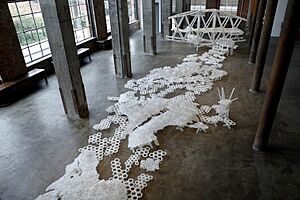Ellen Driscoll facts for kids
Quick facts for kids
Ellen Driscoll
|
|
|---|---|
| Born | 1953 Boston, Massachusetts, US
|
| Education | Columbia University, Wesleyan University |
| Known for | Sculpture, installation art, public art, drawing |
| Spouse(s) | Steven Manning |
| Awards | Guggenheim Fellowship, Anonymous Was a Woman Award, Harvard Radcliffe Institute, National Endowment for the Arts |
Ellen Driscoll (born 1953) is an American artist from New York. She creates many types of art, including sculpture, drawings, and large art installations. She also makes public art that people can see in different places.
Driscoll is known for her detailed artworks. These pieces often explore important topics like social issues and the environment. She uses many different materials and techniques. Her art can combine old methods with new digital tools. She also uses research and storytelling in her work.
Her art often shows everyday things in new and surprising ways. She connects different times and cultures. She also links small, personal actions to bigger global events. She uses light, shadow, and different sizes to make her art powerful.
Art critics have praised Driscoll's work. Patricia C. Phillips said Driscoll's art is interested in "the lives and stories of people whose voices... have been suspended." Jennifer McGregor noted that Driscoll's projects "fluidly map place and time." They explore history, nature, and culture.
Ellen Driscoll has won many important awards. These include fellowships from the Guggenheim Foundation and the National Endowment for the Arts. Her art has been shown in famous places like the Whitney Museum and the New-York Historical Society. Her works are also part of major art collections. These include the Metropolitan Museum of Art and the Whitney Museum.
Contents
Early Life and Art Journey
Ellen Driscoll was born in 1953 in Boston, Massachusetts. She grew up in a large family. She studied painting and sculpture at Wesleyan University. She earned her first art degree in 1974.
After college, she moved to New York City. There, she continued her art studies at Columbia University. She earned a master's degree in sculpture in 1980. She also worked for other famous artists.
Early Sculptures and Recognition
In the 1980s, Driscoll's early sculptures were abstract. They were inspired by furniture and buildings. Her art was shown in group exhibitions. These included shows at the Metropolitan Museum of Art.
Between 1987 and 1990, Driscoll had solo art shows. These shows helped her become well-known. She created sculptures from wood, lead, and copper. These artworks had an old, medieval feel. They explored ideas about memory and old science.
Her sculptures often looked like ancient tools or objects. They were sometimes dark or mysterious. Driscoll often made them black or covered them with lead. She also used oxidized copper. This gave them a handmade, decorative look. Yet, their shapes were very basic.
Critics described her art as both elegant and simple. They called them "organic, anthropomorphic machines." These works showed ideas of "destruction and renewal."
Teaching Art to Students
During this time, Driscoll also started teaching sculpture. She taught at the Rhode Island School of Design. She was a professor there from 1992 to 2013.
In 2013, she joined Bard College. She became a professor and director of studio arts. She continues to share her knowledge with new artists.
Awards and Art Collections
Ellen Driscoll has received many important awards. These include fellowships from the Guggenheim Foundation. She also received awards from the Harvard Radcliffe Institute. The National Endowment for the Arts has also recognized her work.
She has also received grants from other groups. These include the American Academy of Arts and Letters. She has also attended special art programs. These programs allow artists to focus on their work.
Driscoll's art is part of many public collections. These are places where art is kept for everyone to see. Her work is in the Metropolitan Museum of Art. It is also in the Whitney Museum. Other museums with her art include the Detroit Institute of Arts and the Harvard Art Museums.


